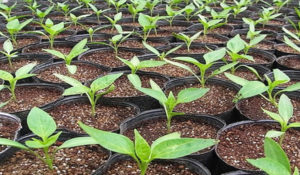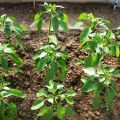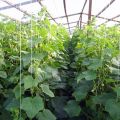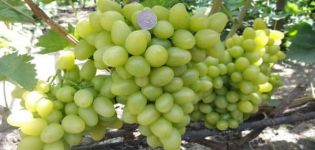How to form peppers in a greenhouse and open field
The formation of pepper in the greenhouse is mandatory for all species of this plant. For each variety, such an event may be slightly different. For example, during the cultivation of sweet peppers, you have to completely remove the stepsons and pinch the top.
If it is necessary to cut off low varieties, then only a small part of the shoots is removed, which is the location below everything.
What varieties need to be formed
Before forming peppers in an open field or a greenhouse, you need to figure out what types of plants need it. Gardeners are engaged in the cultivation of varieties that can be cast among themselves by the duration of ripening. The following types of peppers are distinguished:
- Ultra early - technical maturity is reached in exactly three months.
- Early - the fruits ripen within 100 days.
- Medium early - the first peppers ripen 130 days after planting.
- Late - ripens five months after planting.
Also, the bushes may differ in their height. All varieties can be classified into:
- dwarf - below 40-45 cm;
- undersized - grow up to 50-60 cm;
- medium-sized - the height of the bushes does not exceed 100 cm;
- tall - the average height of an adult plant is about 200 cm.
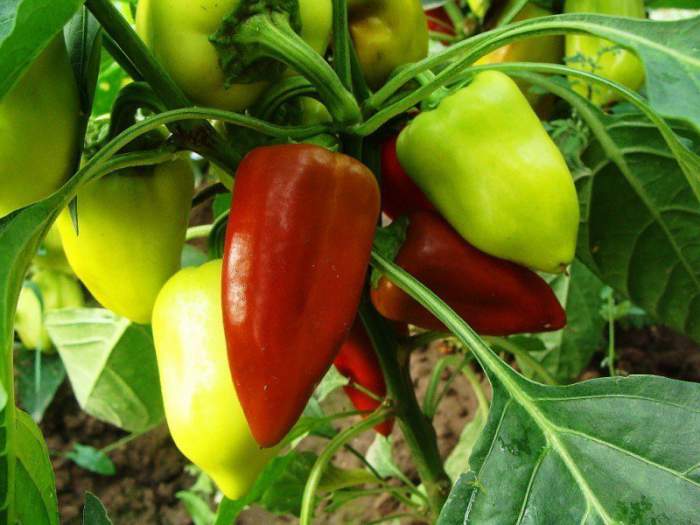
The formation of peppers is carried out for all varieties, except for dwarf ones. They bear fruit well even without pruning the bushes, provided that the planting scheme has been fully followed.
During pinching of undersized bushes, it is enough to cut off weak shoots that grow inward. A tall pepper bush needs a lot of nutrients. If it grows strongly during growth, then ideal conditions will be created for the appearance of dangerous pests and diseases. Therefore, pruning of such bushes is mandatory in order to protect the plant and improve its nutrition.
Formation methods
To understand how to form pepper in the open field, you need to familiarize yourself with the basic methods of pinching. Many varieties are pruned using different methods. There are three main methods for pruning bushes.
One stem
Quite often, this option is used if a lot of seedlings are planted, and the garden is not very spacious. By shaping the bush in this way, the plant will receive more light since most of the shoots and leaves will be removed.
To form a bush in this way, it is necessary to break down all the stepsons and its doubles that appear during the bifurcation of the stems. Only all flower brushes are left on the plant.
Two stems
This method is the most popular because it is suitable for many types of pepper. Thus, you can get a small and powerful bush that can easily support the weight of even the largest fruits.
During the formation of the pepper, not only the main stem is left in two stalks, but also its first stepson. It is he who develops faster than other stems. All other shoots must be gotten rid of.
Three stems
This option is used when few seedlings have to be grown on a large plot. To form a bush into three stems, you must adhere to the following recommendations:
- Two stepsons are left on the plant, which are below the first flower brush.
- The bush is carefully examined and another well-developed and strong stepson is selected.
- All remaining stepchildren are removed.
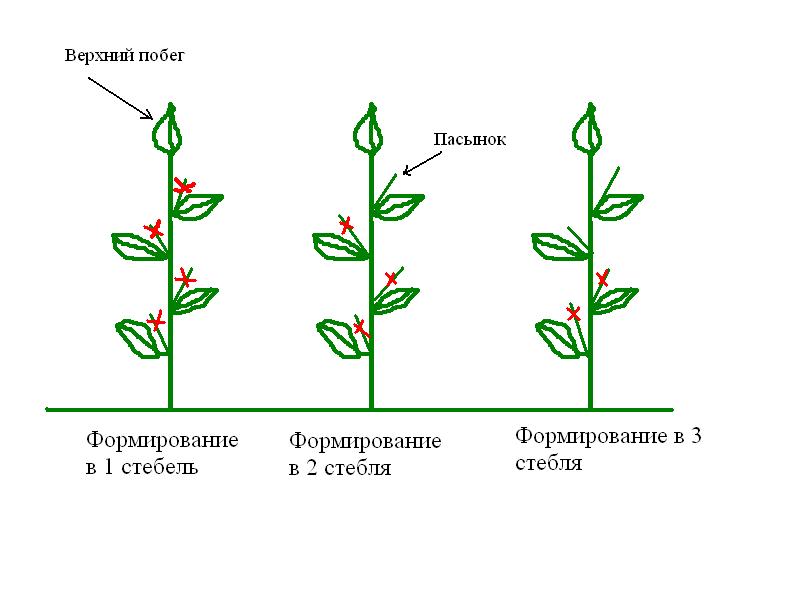
Recommendations
Many people don't know how to pinch peppers in a greenhouse. There are a number of specific rules that will help you perform this procedure correctly:
- Do not pinch peppers if the weather is too hot and dry for several days. In this case, it is better to leave leaves on the bushes so that they can protect the plant from burning out. The formation of a pepper bush in a greenhouse during such a period can lead to its death. By removing all unnecessary shoots, soil and bushes, you will lose additional protection from the sun.
- Pinning tools can carry dangerous infections. Before the procedure, it is recommended to disinfect them with antiseptics.
- Pepper grazing is not carried out if the height of the bush is less than 20-30 cm. This can adversely affect growth and fruiting.
- You can not form a bush if it is sick. Because of this, he may die.
- It is not recommended to peck peppers if they are planted too rarely. The distance between each bush should be at least 25 cm. Bushes, near which there are no other plants, should be left with dense greenery.
Basic techniques
During the formation of plants, three main methods are used.
Topping
The pinching is done in order to stop the growth process and send all the nutrients to the young fruit. Pinching is a must. If this is not done, then all the useful elements will be spent on the development of stepchildren, side shoots and leaves.
Stealing
The bushes are stepchild to provide the fruit with nutrients. It is necessary to remove only those stepsons who have grown to 4-5 cm.
Pruning
Pruning is done when a large number of unnecessary shoots appear. After pruning, only a few of the most developed stems remain on the plant, which are far from each other.
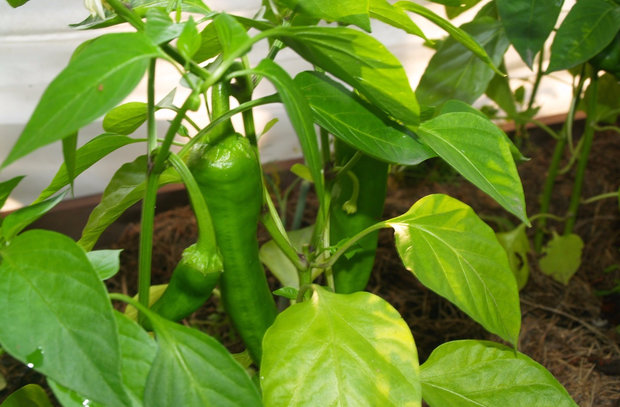
Formation stages
The process of pinching peppers in the open field is carried out in several stages. In this case, it is recommended to use a clean tool that is not covered with rust.
Crown bud
Young seedlings of bell pepper have one stem, but over time, the plant begins to branch and new ones appear. In the place where new branches are formed, the first flower is formed. Quite often it is called the crown bud. The essence of the first stage of formation is to remove it. This is done in order to accelerate the development of culture.
Sometimes several such buds appear on the bushes at once. In this case, you will have to get rid of all the flowers so that the greenhouse pepper can branch well.
This procedure is carried out even if the buds appeared before the pepper was planted in the open ground.
Extra shoots
The second stage of formation is carried out after the first 10 leaves of the bush grow. In this case, in the peppers in the greenhouse, all unnecessary branches are removed and only a few shoots are left, which were formed by the fork of the main bud.Weak branches are shortened - the upper growth point is removed from them. Any remaining shoots will form the base of an adult pepper.
After removing the extra stems, the chilli peppers need to be observed for several weeks. Over time, the shoots will begin to branch and a new bud will appear on each of them. They can also form in internodes. The buds that are there must be removed immediately.
Of all the new stems, you need to choose the strongest, and get rid of the rest. This is done in order to improve the supply of nutrients to the ovaries. This operation should be carried out after each branching of the bush. If weak shoots are not removed in a timely manner, then the plant will gradually begin to weaken.
After the completion of the second stage, the cut bush should have no more than 25 ovaries.
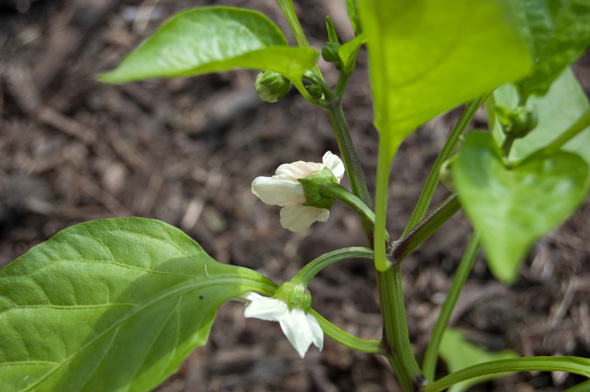
Fruitless shoots
After removing all the excess stems, the sweet pepper bush in the open field or greenhouse begins to develop rapidly. Over time, empty shoots begin to appear on the plants, which will have to be disposed of. They appear in the lower part of the bush, not far from the branching of the main stem.
In addition, at this stage, the bell peppers in the greenhouse are covered with extra leaves, which do not take part in the nutrition of the ovaries and create additional shade. Also, sometimes damaged leaves appear, due to which the plant develops various diseases.
If the extra leaves are not removed in a timely manner, then the yield of the pepper will begin to seriously decrease. To do this, it is recommended to adhere to the following scheme:
- It is necessary to trim the leaves on the main stem only after they enter the stage of technical ripeness. No more than two leaves are removed at a time.
- The second removal should be carried out after the formation of the peppers of the second brush.
- The last stage of leaf removal is carried out 1-2 months before the fruit is fully ripe.
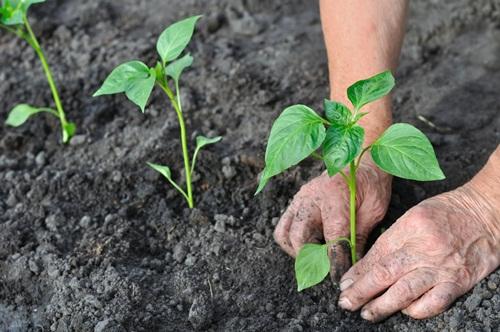
Topping
To form sweet and large fruits, the bushes will have to spend quite a lot of energy, which is often expended to maintain new and unnecessary ovaries. Most novice gardeners make the same mistake - they leave a lot of ovaries that the bushes cannot feed.
At a later stage in the development of peppers, many new flowers appear. However, they do not increase yields, but only weaken the newly formed fruit. It is because of this that the fourth stage of the formation of bushes is carried out, during which growth points are pinched on all branches. Thanks to this, the plant spends all its energy on the development of new peppers.
Conclusion
To understand how to form pepper in a greenhouse or open field, you need to familiarize yourself with some recommendations. It will also help with the formation of pepper in the greenhouse with a video with which you can familiarize yourself with the features of this process.
